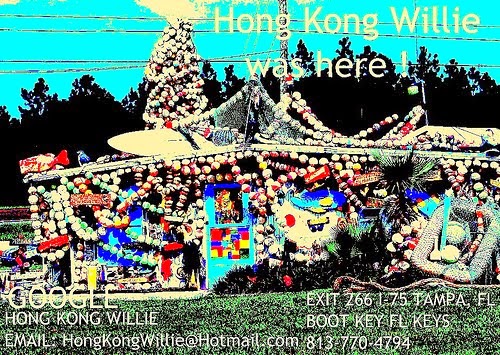You know you have seen it.
Whether you know it as “the Christmas tree” or the “art station,” Hong Kong Willie’s is a spectacular, unique sight.
Seated in the corner of Morris Bridge and I-75, Hong Kong
Willie’s is a gallery where many unique pieces of art are displayed and
sold.
Always seeing this place on our way to school, former
Editor-in-Chief Pankti Mehta and I had wondered about it for a long
time. At the beginning of this summer, we decided to go there and find
out.
As we walked into the blue shack, we were greeted by a
friendly face. Wearing a blue Hawaiian shirt and khaki shorts, and with
his hair pulled back into a ponytail, Joe Brown, or more commonly known
as Hong Kong Willie, welcomed us and shared with us the story of his
life.
Hong Kong Willie is an artist who finds the meaning in
what others would deem as “junk” items. His journey began in his
childhood when he collected discarded items from the landfill where he
lived and sold them.
“By the time I was eight years old, I was walking around with hundreds of dollars in my pockets,” Brown said.
He had never thought he would enter the realm of art, but
his mother knew otherwise. She was the one who made him to go to art
school.
“My mother believed that if you were born to do something, you were to do that,” he said.
At art school, he met the person who would inspire his
nickname. His art teacher explained the importance and meaning behind
insignificant, common items to her students. She had gone to Hiroshima
shortly after the atomic bomb had been dropped, and then had left out of
Hong Kong. Her inspirational story was the reason Brown nicknamed
himself Hong Kong Willie.
When he was in college, the technological industry was
booming, with many new innovations coming out in different areas of
society. Brown decided to step into it. However, after being in the
technological industry for a while, Brown went through a realization:
“I just wasn’t made up for that.”
Knowing that the technological world was filled with
greed, Brown decided to step out of it in 1981. He knew that his life’s
calling was to be artist, and he was going to be just that.
“We are here to tell a story … to take common items that are not manufactured media that have a meaning.”
He set up his station first in the Florida Keys, but then moved to Tampa, where he has now been living for 37 years.
A firm believer in predestination, Brown explains that he got these beliefs from his father.
“My father understood why he was here. And he made that
of great importance to his children… My father gave me the understanding
of why we were here. And to be determined to find that.”
In today’s fast-paced society, teaching of such life
lessons has become rare. People are more motivated to “get famous and
get money,” as Brown put it.
“I’m here just to exemplify and maximize why I’m here. That’s probably the greatest thing that I think is missed in families.”
Hong Kong Willie also explained one of his special
pieces to us, which was called Miriosity. Shaped like a bird, Brown used
the embedded frailties within the wood to bring out the meaning in the
piece.
“Many artists don’t produce more than one great, great,
great piece. And Miriosity, she just has all of those elements…
Miriosity has a great future.”
Hong Kong Willie has supporters who come into his
gallery and buy many of his pieces. With the money that he makes, he
gives back a large portion to various social projects. His art is not
just a business, and he makes that very clear.
“You can only buy a piece of art if you have fallen in
love with it,” he said. He recalled a time when he turned down a buyer
from buying some of his works because he knew the reason for buying
those works was not genuine.
Hong Kong Willie keeps the presence of art alive in
today’s society. Wherever his art goes, a piece of him will forever be
with each piece. We are very grateful for his time and his dedication to
his work.
Visit Hong Kong Willie’s blog here: https://thingstodointampa.blogspot.com/2010/12/things-to-do-in-tampa.html




